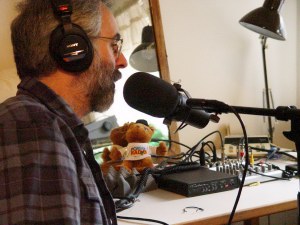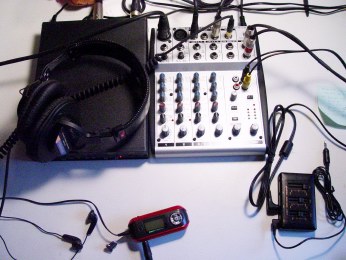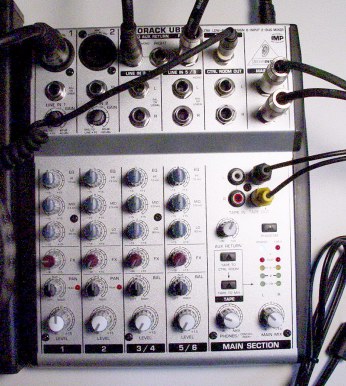danbricklin.com/log
|
|
|
|
My Podcasting Setup
|
I have now (as of May 27, 2005) posted three podcasts for Software Garden which have been listened to by a few thousand people, and have done recordings for some private ones in the past. I'm about to record a lot more. I've done some research and bought some equipment which I've tried. Here's what I've learned so far. Note that I am not an audio engineer, so I may have all the wrong stuff. However, I know that I've appreciated the help of others and I share what I have here hoping it will help others.
Recording Equipment
Most of the podcasts I'm doing are either just me or an interview over the phone with someone else. My setup reflects that. I am not doing Skype recording, though I could if I need to (and I'd add to this setup for that). I decided that for my audience and target interviewees, "traditional" phone recording would be most appropriate to start. Skype problems like drop outs randomly on a voice that sounds like it's in the studio can be strange. Phone funnies are something my target audience of lawyers, managers, and developers are used to. My interviewees mainly don't have Skype, so I'd be connecting to them via a Skype-out phone connection anyway. I plan to use normal telephone conference calling services for multi-person recordings.
I use a microphone, connect it to a phone line with a special box, and then record the mix on my laptop as well as create a backup recording on an MP3 recorder. Here's what I look like doing it:
 The microphone is a Shure SM7B. It cost about $350. Why did I get that? Knowing I was in a noisey environment, with reflections of sound off the walls and a laptop fan, I wanted a directional microphone. I heard Adam Curry say he was using this mike at some point. It seemed to get good reviews. Since this is my main microphone for the next many years and I might use it for video voice overs, etc., I figured I can justify the extra money over the more common SM58 (about $100) or something similar. I like it. It has a nice clean sound, and keeps out the "esses" and other breath sounds very well.
Here's what the main part of my setup looks like:
 Here's just the mixer, a Behringer Eurorack UB802 mixer/preamp (street price about $50):
 The heavier cable in the upper left comes from my microphone and goes into input Mic 1. The low-noise of the preamps is nice since I have to turn the gain all the way up. I have it set to take the signal from the mike and "send" it to the special effects FX Send output (third cable top from the left). That goes to my phone interface box. The result from the box is just the interviewee's voice, coming back in to the UB802 (on the second top cable from the left) through the Aux Return. That then gets mixed into the main mix which also has my voice from Mic 1. The output goes to headphones for me to listen to (which is how I hear the interviewee) on the coiled cable. I have Sony MDR-7506 headphones.
The output also goes to some 1/4" plug cables which are then connected to RCA plugs which are connected to a cable with a small plug to put into my iRiver iFP-890 256MB flash MP3 player. The iRiver can record direct to MP3 and is my "backup" recorder. I have it set to look for a Line-In level source, and set the volume at 40, which seems to have low noise but not be so high as to have clipping (when the signal goes over 100% and gets cut there as a flat level, sounding very bad). I record at a 44KHz sampling rate with compression to a bitrate of 160Kbps. The high bitrate is so that I can uncompress it and still have something clean enough to recompress at the lower rate I'll use in the end.
The last output of the mixer is from the Tape Out and goes to a little mixer (just a volume control, actually) and then from there into my laptop's microphone input. I use the second mixer (which you probably don't need) to let me have the meter on the UB802 in a reasonable range, the iRiver get a signal at a level it likes, and the laptop not get too high a signal (too high and it clips).
Phone Equipment
For connecting to the phone, I went with a unit recommended by Doug Kaye of ITConversations (he's one of the main people I've listened to for advice). It's a Telos ONE. It's what's called a "hybrid" which means it takes the analog signal of my microphone and the phone line, converts them to digital and does signal processing in a DSP to separate out my voice from the interviewee's. Otherwise, my voice would drown out the phone call. It works quite well. The output can be either just the interviewee (called the "caller" -- this is for talk shows) or both of us. It has manual gain settings and auto gain controls. The instructions it comes with are helpful. It cost me about $550 for a new one from one of their authorized dealers (BSW).
Checking this out on the web, I see that NPR has some of these in their studios, as do lots of other "pros". I did see a reference to some hum problem. I had that problem whenever the phone was connected at one point. You'd hear some hum in the earphones, as well as in the final output. I traced it to a ground problem of some sort between my laptop and the rest of the setup. When I unplugged the laptop from the mixer the hum went away. When I ran the laptop on batteries instead of AC power the hum went away, too. So, I record on my laptop with battery and not connected to AC. With 30-40 minute recordings this is no problem.
I have the "modem case" version (the least expensive) of the Telos ONE. The others are functionally the same, but in different cases such as rack mounting. Here's the front and back view:
  Processing the recording
I record on the laptop with CoolEdit 2000 (now sold by Adobe as Audition). (Sometimes I do other recording or editing with Audacity.) I record as mono sampled at 44KHz. I save the original as a .WAV file, and then edit a copy (I learned to do that the hard way, and when I was saved by my "backup" iRiver MP3 I was reenforced there, too).
I've gotten help from Doug Kaye (to me, the "PodGod" in so many ways) on what to do next. This comes from essays like those on his forum and elsewhere on ITConversations. Some I've figured out myself. Here's what I do:
I convert everything to mono if it isn't already. I then run a dynamic range filter that limits the volume of things to a more narrow range. Right now, I use a flat 1:1 compression below minus 10dB and infinite compression above minus 10dB (those numbers subject to change). I then apply a frequency filter that has an 80Hz high-pass filter (Doug says stuff down there isn't interesting to voice in podcasts) and a 11,025Hz low-pass filter (phone conversations are all way below that and my final 22,050Hz sampling won't handle much more than that anyway). This makes the amount of information that needs to be compressed into an MP3 less than it would be otherwise without much noticable loss. I then amplify the whole thing to make the peaks hit about 100% (that means that once or twice in the recording I may get some clipping with the way the compression worked, but the overall level is fine) and the main sound be around minus 6dB. Then I transform the whole thing to 22,050Hz sampling stereo. As Doug points out, stereo with both channels identical doesn't pay a file size price when encoded as MP3 nor effect quality much.
Now I have my main recording ready. I copy and paste in my standard introduction and closing recordings (already processed this way) and any other additional stuff. I add the MP3 ID3 tags with a song title (the same as the file name I use), artist (me), album name (a short string that's always the same for all my related podcasts to help the music organizers on your computer), genre (the closest thing in CoolEdit is "speech" -- I wanted "podcast"...), and a short comment with the name and affiliation of the interviewee.
Finally, I save/compress the results as an MP3 with a bitrate of 64Kbps (a common nice balance between size and quality), sampling rate of 22,050Hz, Int Stereo for stereo (see Doug's forum why - he says to use "Joint Stereo with the IS option...MS stereo is designed for bit rates above 128kbps"), and tell it to take as long as necessary to do as good a job as possible.
I upload the final file to my website using a normal FTP program. For now, I'm using a separate account at Interland to hold them that gives me 500GB/month of transfer, which should be enough for me for now. My website and RSS feed are on the www.softwaregarden.com server. The RSS feed points to the MP3 files as enclosures. To create the RSS feed and a companion HTML page I use an new, alpha version of ListGarden that supports enclosures. It lets me browse the directory containing uploaded files and just select the one I want (they're sorted in reverse chronological order), automatically filling in the file size, etc. (That version of ListGarden is still in test -- it has some bugs so I can't release it yet. [It now has been released--DanB, 8/05])
That's it for now!
-Dan Bricklin, May 27, 2005
|
|
|
© Copyright 1999-2018 by Daniel Bricklin
All Rights Reserved.
See disclaimer on home page.
|